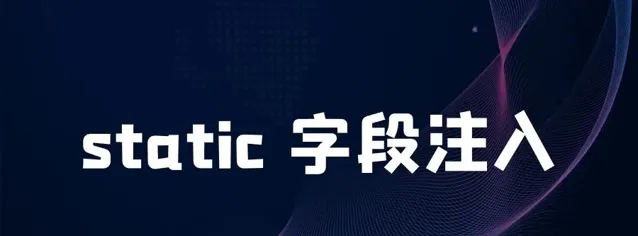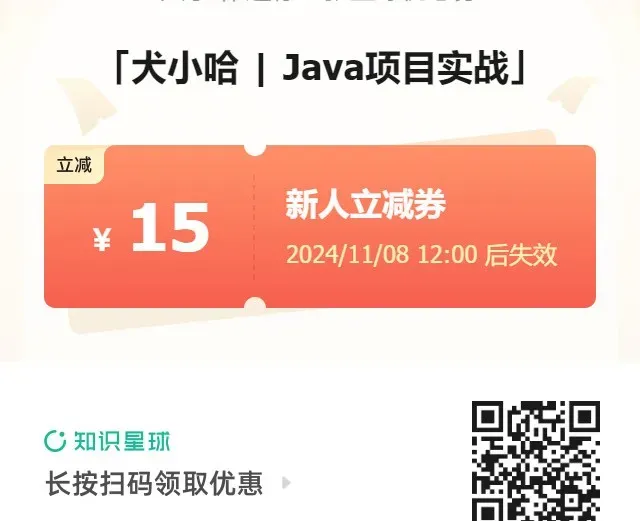
👉 欢迎 ,你将获得: 专属的项目实战 / Java 学习路线 / 一对一提问 / 学习打卡 / 每月赠书
新项目: 仿小红书 (微服务架构)正在更新中... , 全栈前后端分离博客项目 2.0 版本完结啦, 演示链接 : http://116.62.199.48/ 。全程手摸手,后端 + 前端全栈开发,从 0 到 1 讲解每个功能点开发步骤,1v1 答疑,直到项目上线。 目前已更新了261小节,累计43w+字,讲解图:1806张,还在持续爆肝中.. 后续还会上新更多项目,目标是将Java领域典型的项目都整一波,如秒杀系统, 在线商城, IM即时通讯,Spring Cloud Alibaba 等等,
我们都知道Spring在创建一个bean的时候,还要去填充bean的属性
大致流程如下:
反射创建bean——
createBeanInstance
填充bean——
populateBean
初始化bean——
initializeBean
(包括前后置增强)
注册bean的销毁方法——
registerDisposableBeanIfNecessary
这个填充bean的逻辑是在
populateBean
中
protected void populateBean(String beanName, RootBeanDefinition mbd, @Nullable BeanWrapper bw) {
// ...
PropertyDescriptor[] filteredPds = null;
if (hasInstAwareBpps) {
if (pvs == null) {
pvs = mbd.getPropertyValues();
}
for (InstantiationAwareBeanPostProcessor bp : getBeanPostProcessorCache().instantiationAware) {
// here
PropertyValues pvsToUse = bp.postProcessProperties(pvs, bw.getWrappedInstance(), beanName);
if (pvsToUse == null) {
if (filteredPds == null) {
filteredPds = filterPropertyDescriptorsForDependencyCheck(bw, mbd.allowCaching);
}
pvsToUse = bp.postProcessPropertyValues(pvs, filteredPds, bw.getWrappedInstance(), beanName);
if (pvsToUse == null) {
return;
}
}
pvs = pvsToUse;
}
}
// ...
if (pvs != null) {
applyPropertyValues(beanName, mbd, bw, pvs);
}
}
而除了
applyPropertyValues
可以填充bean的属性外
更多的填充逻辑(字段注入)应该是在
InstantiationAwareBeanPostProcessor
中的
postProcessProperties
里面,字段注入就是常用的
@Autowired
、
@Resource
注解
InstantiationAwareBeanPostProcessor
是一个接口
它的子类中实现Autowired注入的是
AutowiredAnnotationBeanPostProcessor
,实现Resource注入的是
CommonAnnotationBeanPostProcessor
接下来分析一下
AutowiredAnnotationBeanPostProcessor
是怎么进行字段注入的
// AutowiredAnnotationBeanPostProcessor.postProcessProperties
@Override
public PropertyValues postProcessProperties(PropertyValues pvs, Object bean, String beanName) {
// 找到需要Autowired的元数据(字段、方法)
InjectionMetadata metadata = findAutowiringMetadata(beanName, bean.get class(), pvs);
try {
// 注入
metadata.inject(bean, beanName, pvs);
}
catch (BeanCreationException ex) {
throw ex;
}
catch (Throwable ex) {
throw new BeanCreationException(beanName, "Injection of autowired dependencies failed", ex);
}
return pvs;
}
以上这段代码是
AutowiredAnnotationBeanPostProcessor
实现的
postProcessProperties
流程就是先找到需要通过
findAutowiringMetadata
找到需要Autowired的元数据(字段、方法) ,然后再inject
先看看
findAutowiringMetadata
// AutowiredAnnotationBeanPostProcessor.findAutowiringMetadata
private InjectionMetadata findAutowiringMetadata(String beanName, class<?> clazz, @Nullable PropertyValues pvs) {
// Fall back to class name as cache key, for backwards compatibility with custom callers.
String cacheKey = (StringUtils.hasLength(beanName) ? beanName : clazz.getName());
// Quick check on the concurrent map first, with minimal locking.
InjectionMetadata metadata = this.injectionMetadataCache.get(cacheKey);
if (InjectionMetadata.needsRefresh(metadata, clazz)) {
synchronized (this.injectionMetadataCache) {
metadata = this.injectionMetadataCache.get(cacheKey);
if (InjectionMetadata.needsRefresh(metadata, clazz)) {
if (metadata != null) {
metadata.clear(pvs);
}
metadata = buildAutowiringMetadata(clazz);
this.injectionMetadataCache.put(cacheKey, metadata);
}
}
}
return metadata;
}
这个
needsRefresh
简单看看就好,我们是第一次进入这个方法,所以这个metadata是null,那么这个方法返回的是true
public static boolean needsRefresh(@Nullable InjectionMetadata metadata, class<?> clazz) {
return (metadata == null || metadata.needsRefresh(clazz));
}
那么会进入到这个方法
buildAutowiringMetadata
private InjectionMetadata buildAutowiringMetadata(final class<?> clazz) {
if (!AnnotationUtils.isCandidate class(clazz, this.autowiredAnnotationTypes)) {
return InjectionMetadata.EMPTY;
}
List<InjectionMetadata.InjectedElement> elements = new ArrayList<>();
class<?> target class = clazz;
do {
final List<InjectionMetadata.InjectedElement> currElements = new ArrayList<>();
// 处理字段
ReflectionUtils.doWithLocalFields(target class, field -> {
MergedAnnotation<?> ann = findAutowiredAnnotation(field);
if (ann != null) {
if (Modifier.isStatic(field.getModifiers())) {
if (logger.isInfoEnabled()) {
logger.info("Autowired annotation is not supported on static fields: " + field);
}
return;
}
boolean required = determineRequiredStatus(ann);
currElements.add(new AutowiredFieldElement(field, required));
}
});
// 处理方法
ReflectionUtils.doWithLocalMethods(target class, method -> {
Method bridgedMethod = BridgeMethodResolver.findBridgedMethod(method);
if (!BridgeMethodResolver.isVisibilityBridgeMethodPair(method, bridgedMethod)) {
return;
}
MergedAnnotation<?> ann = findAutowiredAnnotation(bridgedMethod);
if (ann != null && method.equals( classUtils.getMostSpecificMethod(method, clazz))) {
if (Modifier.isStatic(method.getModifiers())) {
if (logger.isInfoEnabled()) {
logger.info("Autowired annotation is not supported on static methods: " + method);
}
return;
}
if (method.getParameterCount() == 0) {
if (logger.isInfoEnabled()) {
logger.info("Autowired annotation should only be used on methods with parameters: " +
method);
}
}
boolean required = determineRequiredStatus(ann);
PropertyDescriptor pd = BeanUtils.findPropertyForMethod(bridgedMethod, clazz);
currElements.add(new AutowiredMethodElement(method, required, pd));
}
});
elements.addAll(0, currElements);
// 获取父类,继续找
target class = target class.getSuper class();
}
while (target class != null && target class != Object. class);
return InjectionMetadata.forElements(elements, clazz);
}
这边传入的clazz就是bean的 class,忘记了可以找上面的代码看一下
这里源码写了很多,我们暂时只关心注入字段的那一块
ReflectionUtils.doWithLocalFields(target class, field -> {
MergedAnnotation<?> ann = findAutowiredAnnotation(field);
if (ann != null) {
if (Modifier.isStatic(field.getModifiers())) {
if (logger.isInfoEnabled()) {
logger.info("Autowired annotation is not supported on static fields: " + field);
}
return;
}
boolean required = determineRequiredStatus(ann);
currElements.add(new AutowiredFieldElement(field, required));
}
});
处理字段的时候进入了
ReflectionUtils
的
doWithLocalFields
方法
// ReflectionUtils.doWithLocalFields
public static void doWithLocalFields( class<?> clazz, FieldCallback fc) {
for (Field field : getDeclaredFields(clazz)) {
try {
fc.doWith(field);
}
catch (IllegalAccessException ex) {
throw new IllegalStateException("Not allowed to access field '" + field.getName() + "': " + ex);
}
}
}
继续追溯一下可以得知,这里是获取clazz的所有字段并进行处理,这个
FieldCallback
是一个函数式接口,它的实现就是外面传进来的这段代码
field -> {
MergedAnnotation<?> ann = findAutowiredAnnotation(field);
if (ann != null) {
if (Modifier.isStatic(field.getModifiers())) {
if (logger.isInfoEnabled()) {
logger.info("Autowired annotation is not supported on static fields: " + field);
}
return;
}
boolean required = determineRequiredStatus(ann);
currElements.add(new AutowiredFieldElement(field, required));
}
}
那么在这段代码里面,又去找这个字段有没有被
@Autowired
修饰
// AutowiredAnnotationBeanPostProcessor.findAutowiredAnnotation
@Nullable
private MergedAnnotation<?> findAutowiredAnnotation(AccessibleObject ao) {
MergedAnnotations annotations = MergedAnnotations.from(ao);
// autowiredAnnotationTypes包含 @Autowired,@Value,@Inject
for ( class<? extends Annotation> type : this.autowiredAnnotationTypes) {
MergedAnnotation<?> annotation = annotations.get(type);
if (annotation.isPresent()) {
return annotation;
}
}
return null;
}
如果有
@Autowired
修饰,那么lambda中的ann不为null
最关键的地方来了,接下来会判断这个字段是不是static的,如果是,那么会发出警告,并且直接返回,不进行注入了
field -> {
MergedAnnotation<?> ann = findAutowiredAnnotation(field);
if (ann != null) {
// 判断是否被static修饰
if (Modifier.isStatic(field.getModifiers())) {
if (logger.isInfoEnabled()) {
logger.info("Autowired annotation is not supported on static fields: " + field);
}
return;
}
boolean required = determineRequiredStatus(ann);
currElements.add(new AutowiredFieldElement(field, required));
}
}
最终注入的逻辑在
InjectionMetadata
的inject中
// InjectionMetadata.inject
public void inject(Object target, @Nullable String beanName, @Nullable PropertyValues pvs) throws Throwable {
Collection<InjectedElement> checkedElements = this.checkedElements;
Collection<InjectedElement> elementsToIterate =
(checkedElements != null ? checkedElements : this.injectedElements);
if (!elementsToIterate.isEmpty()) {
for (InjectedElement element : elementsToIterate) {
element.inject(target, beanName, pvs);
}
}
}
element的逻辑就暂时省略了,大概就是如果是字段,那么通过反射去注入,如果是方法,也通过反射去执行
@Resource
与以上大致同理
总结
总的来说,就一句话,spring在使用字段注入对静态字段进行注入时,会忽略掉这个字段,不去注入
也就是说Spring是有能力去注入静态字段的,但是Spring没有选择注入,为什么呢?
可能是因为Spring的设计理念是管理bean对象,只有属于对象的字段Spring才去进行管理,如果是static的话,那么这个字段属于类了,这个时候Spring去进行管理貌似不符合它的设计理念,所以Spring直接忽略掉了;另外如果一个bean修改了这个字段,那么所有bean的这个字段都会受到影响,因为这个字段是属于类的,这个时候可能就会问题
那么有没有办法实现静态字段注入呢?
可以的,在方法中打上@Autowired注解,在方法里面去对静态字段进行赋值,当然这个方法也不能是静态的,否则也会被spring会忽略掉
不过如果能够不对静态字段注入就尽量不要注入,因为spring本身就不鼓励我们这么做,这种不鼓励已经深入到代码里面了
👉 欢迎 ,你将获得: 专属的项目实战 / Java 学习路线 / 一对一提问 / 学习打卡 / 每月赠书
新项目: 仿小红书 (微服务架构)正在更新中... , 全栈前后端分离博客项目 2.0 版本完结啦, 演示链接 : http://116.62.199.48/ 。全程手摸手,后端 + 前端全栈开发,从 0 到 1 讲解每个功能点开发步骤,1v1 答疑,直到项目上线。 目前已更新了261小节,累计43w+字,讲解图:1806张,还在持续爆肝中.. 后续还会上新更多项目,目标是将Java领域典型的项目都整一波,如秒杀系统, 在线商城, IM即时通讯,Spring Cloud Alibaba 等等,

1.
2.
3.
4.
最近面试BAT,整理一份面试资料【Java面试BATJ通关手册】,覆盖了Java核心技术、JVM、Java并发、SSM、微服务、数据库、数据结构等等。
获取方式:点「在看」,关注公众号并回复 Java 领取,更多内容陆续奉上。
PS:因公众号平台更改了推送规则,如果不想错过内容,记得读完点一下「在看」,加个「星标」,这样每次新文章推送才会第一时间出现在你的订阅列表里。
点「在看」支持小哈呀,谢谢啦











